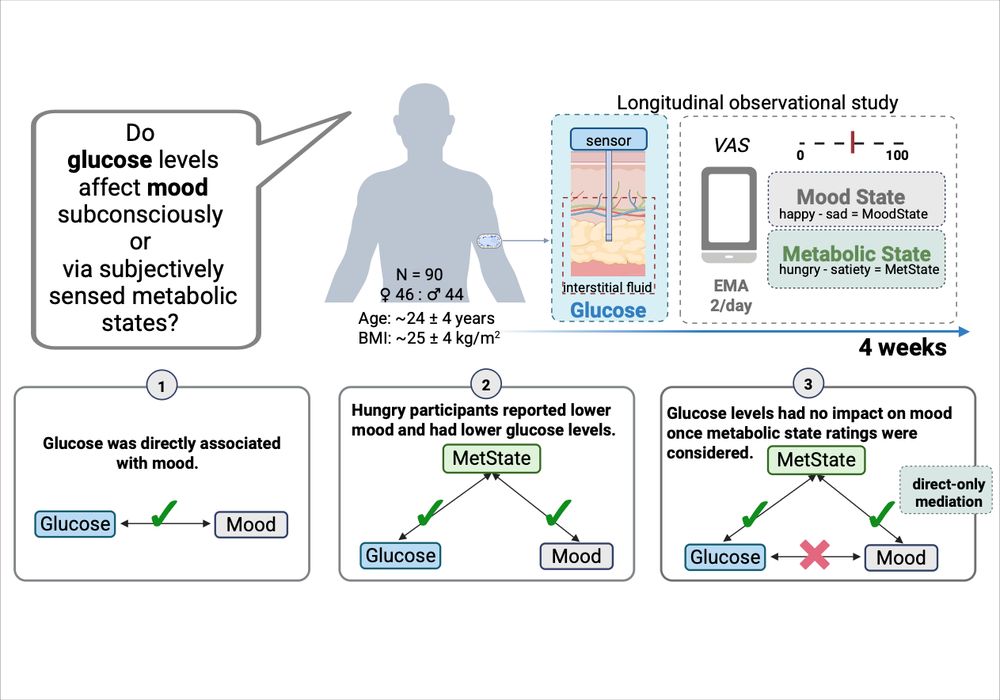DondersInst, into decision-making, learning, ultrasound stimulation, improving psychology & neuroscience. he/him
🎉⛰️🧀🍫🎉
Hunger often affects our mood, but is this a conscious or a subconscious process? Using continuous glucose monitoring, we show that differences in mood are driven by hunger ratings, not just glucose. #neuroskyence 🩺
www.thelancet.com/journals/EBI...

Hunger often affects our mood, but is this a conscious or a subconscious process? Using continuous glucose monitoring, we show that differences in mood are driven by hunger ratings, not just glucose. #neuroskyence 🩺
www.thelancet.com/journals/EBI...
www.nature.com/articles/s41...

www.nature.com/articles/s41...
Have you ever computed noise ceilings to understand how well a model performs? We wrote a clarifying note on a subtle and common misapplication that can make models appear quite a lot better than they are.
osf.io/preprints/ps...
Have you ever computed noise ceilings to understand how well a model performs? We wrote a clarifying note on a subtle and common misapplication that can make models appear quite a lot better than they are.
osf.io/preprints/ps...
www.nature.com/articles/s41...

www.nature.com/articles/s41...
However, he was -- and let's be slightly glib here -- some guy from The Netherlands who wrote social psychology papers.
The full accounting of the Eysenck case is approx, at minimum, TWO STAPELS.
retractionwatch.com/2025/12/03/n...

However, he was -- and let's be slightly glib here -- some guy from The Netherlands who wrote social psychology papers.
The full accounting of the Eysenck case is approx, at minimum, TWO STAPELS.
retractionwatch.com/2025/12/03/n...
www.cell.com/trends/cogni...

www.cell.com/trends/cogni...
www.gao-unit.com/join-us/
If comp neuro, ML, and AI4Neuro is your thing, or you just nerd out over brain recordings, apply!
I'm at neurips. DM me here / on the conference app or email if you want to meet 🏖️🌮

www.gao-unit.com/join-us/
If comp neuro, ML, and AI4Neuro is your thing, or you just nerd out over brain recordings, apply!
I'm at neurips. DM me here / on the conference app or email if you want to meet 🏖️🌮
rdcu.be/eSwvU

rdcu.be/eSwvU



We aimed to cover all the foundations of the topic in an accessible manner for a large audience.
It could help set up a bachelor-level curriculum on the topic.
Pre-orders are very key for the fate of books: shorturl.at/Dxbif


We aimed to cover all the foundations of the topic in an accessible manner for a large audience.
It could help set up a bachelor-level curriculum on the topic.
Pre-orders are very key for the fate of books: shorturl.at/Dxbif


(with @judithschepers.bsky.social & @benediktehinger.bsky.social)
Do you have RTs in your 🧠📈-data? Fixation durations?
How do event-durations affect your data? And how to deal with this?
doi.org/10.1162/IMAG...
🧵 ⤵ 1 / 7
🧪 #EEG #fMRI #neuroimage

(with @judithschepers.bsky.social & @benediktehinger.bsky.social)
Do you have RTs in your 🧠📈-data? Fixation durations?
How do event-durations affect your data? And how to deal with this?
doi.org/10.1162/IMAG...
🧵 ⤵ 1 / 7
🧪 #EEG #fMRI #neuroimage

- doesn’t linearize, distorting similarity metrics
- is biased by temporal jitter across epochs
- may miss important dimensions for transient amplification
If you think there is a state space, use a state space model!

- doesn’t linearize, distorting similarity metrics
- is biased by temporal jitter across epochs
- may miss important dimensions for transient amplification
If you think there is a state space, use a state space model!
pmc.ncbi.nlm.nih.gov/articles/PMC...

pmc.ncbi.nlm.nih.gov/articles/PMC...
Multi-scale parameterization of neural rhythmicity with lagged Hilbert autocoherence
doi.org/10.1162/IMAG...

'Prof Hewstone turned up unannounced & dropped his trousers ... touched women inappropriately ... made comments about relationships with students'
Oxford will do nothing, betcha
Brutal from Bloomberg
www.bloomberg.com/news/feature...

'Prof Hewstone turned up unannounced & dropped his trousers ... touched women inappropriately ... made comments about relationships with students'
Oxford will do nothing, betcha
Brutal from Bloomberg
www.bloomberg.com/news/feature...
I am extremely happy to share this new review article in elife on #Traveling_Waves!
@erc.europa.eu
@upcite.bsky.social
elifesciences.org/articles/106...

I am extremely happy to share this new review article in elife on #Traveling_Waves!
@erc.europa.eu
@upcite.bsky.social
elifesciences.org/articles/106...
Why is cognitive effort experienced as costly?
(or why does it hurt to think)
never written a review paper before in my life, that was a new and unusual experience

Why is cognitive effort experienced as costly?
(or why does it hurt to think)
never written a review paper before in my life, that was a new and unusual experience

